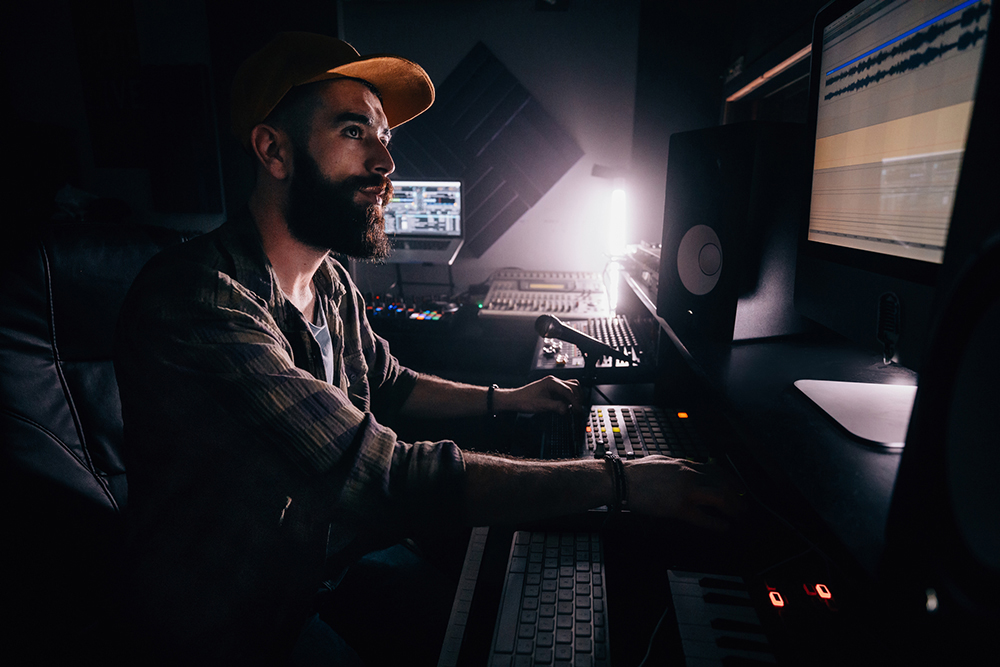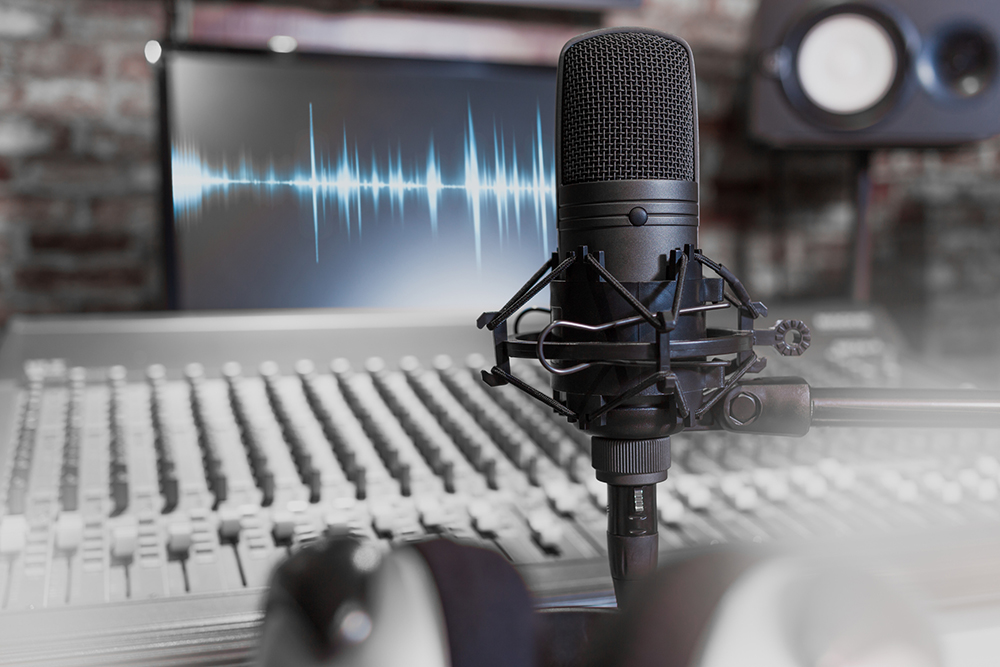We will hear a different answer in Hollywood or Netflix studios – where the importance of sound has been understood for a long time – and another will be given in our backyard, where there is still a problem with understanding the importance of the sound layer.
Grzegorz Sorbee Sorbian from Prodigious Poland – about the process of creating sound.
Sound is at least half of a film piece, and it doesn’t matter if it’s a feature-length form, a commercial or a series. It is half as important as the image, and sometimes more important. I’m sure you’ve heard it said that a film couldn’t have made it without epic music or spectacular sound design.
So why is it sometimes difficult or impossible for us to understand the importance of the sound layer?
Perhaps because, contrary to our conviction – after all, we all have ears and musical taste – we do not know enough about the process of creating sound in films and the multithreading of this issue. We don’t know enough about the work of the people involved in the production and development of sound, otherwise we wouldn’t call everyone “sound engineers”.
In fact, people who work in sound studios are “sound engineers” responsible for professional recording, mixing or mastering sound material. In addition to basic production functions, “sound directors” are predisposed to creative tasks. That is, they are capable of directing dubbing or voiceover recording for commercials, and have sufficient knowledge of music to provide services falling under the umbrella of music consulting, such as matching appropriate music to a spot, and finally “sound designers and composers” – producing original sounds or music.
Of course, I never get offended when someone calls me a “sound designer”, which is actually someone who deals with professional sound recording on a film set. While the term “sound director and sound designer” definitely fits better here. After all, it’s not a matter of ambition, but a concern and lack of understanding of my role/function, which can imply a lack of trust in competence.
How often do we, as studio people, hear from our clients that “something” – usually the music or the voiceover accompanying it – is too quiet or too loud. After all, the volume ratio is the most basic parameter of our studio work. If we, the studio people (producers, sound directors), are not able to assess that something is too loud or too quiet, we know nothing about our work and should leave our workstation with our heads hanging low.
So is it possible to make the world a better place and describe the world of sound and methods of working on it in a way that avoids laboratory-like detail?
Yes! Let me try…
Firstly, we need to distinguish two basic stages of creating the sound layer – consisting of several sound planes – within which we have music, voices, synchronous effects and atmospheres.
The first, is the recording of the sound.
It does not matter whether it is a recording of a music band or symphonic orchestra, dialogues recorded on the set of a film or an advertising spot, or recording a voiceover for a documentary. This stage is the registration and recording of sound using microphones, and in simple terms – the production stage, which requires specialized equipment and techniques.
The second stage is working on the recorded material.

The post-production of sound on many levels – cleaning the sound recorded on set, synchronization with the image of the voice recorded in the studio, choosing the right sound effects for the elements of the image, editing the previously recorded music with the image, or finally setting the right proportions of all the elements (mix) and ultimately setting the volume and sound parameters according to the requirements and technical specifications (mastering).
Due to the nature of our work we will mainly look at what happens in the post-production sound studio. In such a studio we deal mainly with the development of already recorded sound, although work on sound recording occurs here frequently, mainly on the occasion of voiceover recordings or recordings of sounds required to create synchronized sound effects.
Music – yes, it is often the most important sound element of our film work. In the case of commercials, we expect the music to “carry” the whole, to give character, to emphasize important moments, to elevate them. Most often, we work on a ready-made piece, obtained from a stock music (a vast database of ready-made pieces from every musical genre known to us) or composed by a composer especially for this occasion. Finding stock music is a separate and rather difficult field that we call music consulting. Most often, we are given a brief or reference piece with a request to search for a similar one in the stock. Deciphering the brief is often more difficult than the search itself. People creating the brief usually use nomenclature that is not related to music, e.g. they describe the mood, energy and application of the piece. Our task is to transfer these features to the musical ground and find a suitable proposal, and the knowledge of genres and music construction is essential here. Do you know what the funniest brief I ever got was? “We would like ask for music that is good to listen to on the train”. Of course, it was a piece with a distinctive repetitive rhythm, reminiscent of the clatter of a moving train….
And when it comes to a reference song to use as a search pattern, it’s usually a hit that’s currently high up on the charts. Worse, finding a similar one in the stock is next to impossible. Of course, the song we want to use is longer than the form of our work, so we have to adjust it to the desired length so that it doesn’t lose its qualities and at the same time fits the story we’re telling. In an ideal world, we edit the film to the music to take advantage of its rhythmic nature, but we also often have to adapt the music to the film that has already been edited.
Creating short jingles from pre-made stock tracks is also a common occurrence in the post production sound studio. Composing the music itself is most often done using virtual instruments, without involving all the musicians.
Voiceover recordings and voiceover development – this interesting field of “working with sound” is one of the more complex and demanding ones. The recording itself requires a lot of concentration, because you have to watch over many important elements: diction, compliance with the text, the pace of reading, interpretation, intonation. If there is no sound director in the studio, the film director should assist the producer in making sure that the voiceover interpretation is consistent with the assumptions. It is also necessary to supervise that the recording is done in accordance with the art and technical requirements – an appropriate microphone, recording volume, the distance of the reader from the microphone (not every recording can be done with the use of the “close-up effect”, when the reader maintains a small, several-centimeter distance from the microphone).

Let’s also not forget that voiceovers are people with a whole set of personal qualities that determine the comfort of working with them. The statement that the younger and less experienced the lector, the more complications there are in recording them is not far from the truth. The recorded voice is subjected to specific processing – editing, i.e. trimming and fitting it to the image, and often also speeding it up and giving it proper sound, among others through compression and tone correction.
Audio restoration (commonly known as RESTORING) – is the cleaning of the sound from all unwanted elements. Most often accompanying the set recorded on the set (i.e. voices of the characters from recorded scenes, shots). The conditions on the film set are far from the sterile conditions of a recording studio, so all the recordings from the set are burdened with unwanted additives – sounds, reverberations, murmurs, noises, etc. Our task in the studio is to clean all the unwanted sounds, while maintaining the natural sound of what we leave behind – the voices of the characters. Of course RESTORING is not limited to such cases. We sometimes work on de-noising old archival recordings or radio broadcasts. All, of course, with the use of complicated studio tools such as Spectral De Noiser.
Synchronous effects, atmospheres, Sound Design – for many the most interesting issues in creating the sound layer. Probably all of us have seen films about the work of Hollywood Foley’s Masters, i.e. specialists in the production of synchronous sounds (the name comes from Jack Foley – one of the first in this field). The sounds of thunderstorm obtained by recording strikes on a piece of corrugated sheet metal, or windmills simulating gusts of wind.
Creativity while working on sound design has no limits. Imagine that the spectacular sound of a moving spaceship (in one of the contemporary sci-fi movies) was created by recording…. of a hotel hair dryer (after multilayer processing, of course). But how to sound a rolling grapefruit? A scene from a commercial. Just record…. a rolling grapefruit. Sometimes replacing yellow with red helps – true story.
Of course, during the complex work of creating successive sound sets in the film, we do not record all the sounds, only some of them are taken from vast sound bases. Atmospheres of cities (cars, people in the park, birds), sounds of all the machines of the world, footsteps in thousands of varieties, sounds of nature – all this is in ready-to-use collections. However, you need to use them skillfully, often combine several of them and change their characteristics to get a reliable effect.
Mixing and mastering – in order to make all the elements of the sound layer sound coherent, we have to mix them. Adjust the volume proportions, master the frequencies masking each other, emphasize the elements that need exposure. This is not an easy process, it requires many tools (compressors, equalizers, delay, reverb), but the basic and indispensable accessory for its implementation is … a good ear! The last stage of working on the sound is mastering. Let’s conventionally call it the “final cut”, setting the “final volume and sound”, adapting the material to the applicable standards (different for TV specifications, other for the Internet, radio or cinema).
Finally, let’s return to the question posed at the beginning of this article. Although the above analysis is rather superficial, it can be seen with the naked eye, that working on sound is a vast and complex field, requiring us to “put our ear in” much deeper and more carefully than when we listen to “Beethoven’s Fifth” in a comfortable chair.
Maybe now you can hear more while watching the movie on Netflix?
Try to “decompose” the sound layer in your favorite movie into individual plans – voices, music, effects, atmospheres.
It will surely help you to make a simple statement – SOUND IS IMPORTANT!!!


